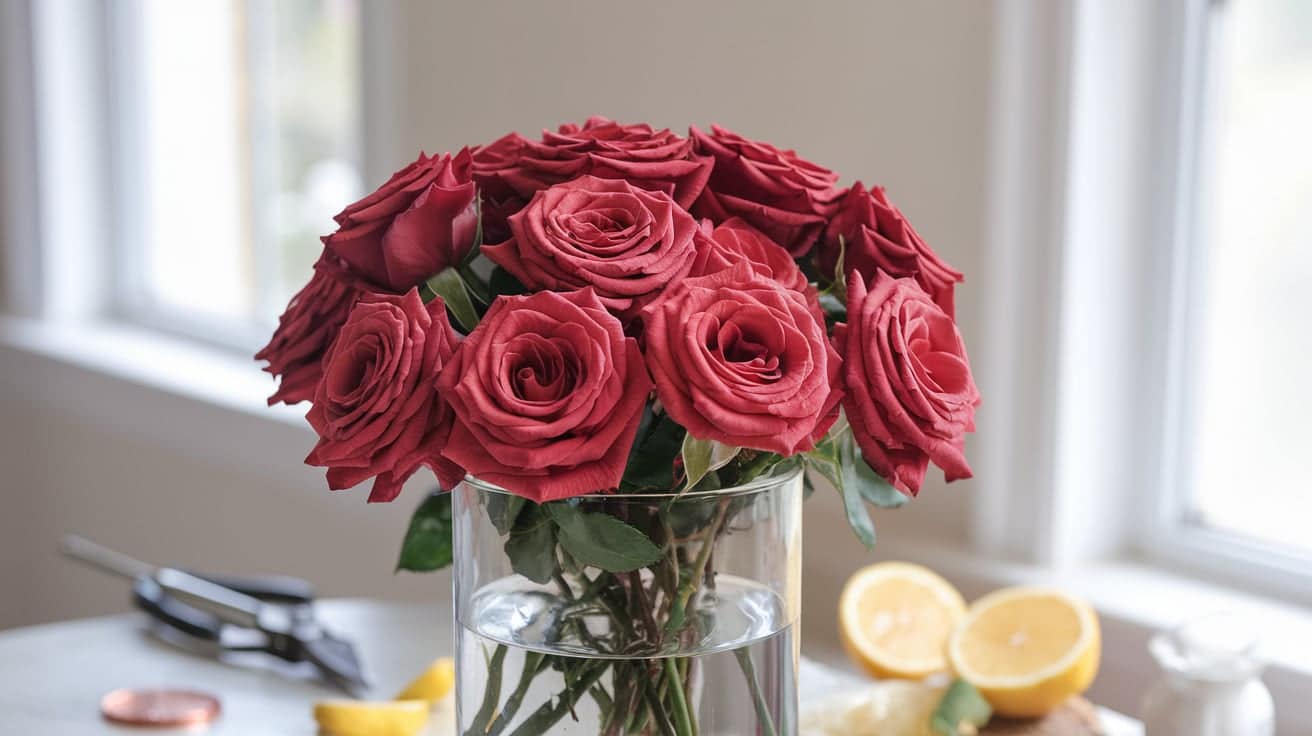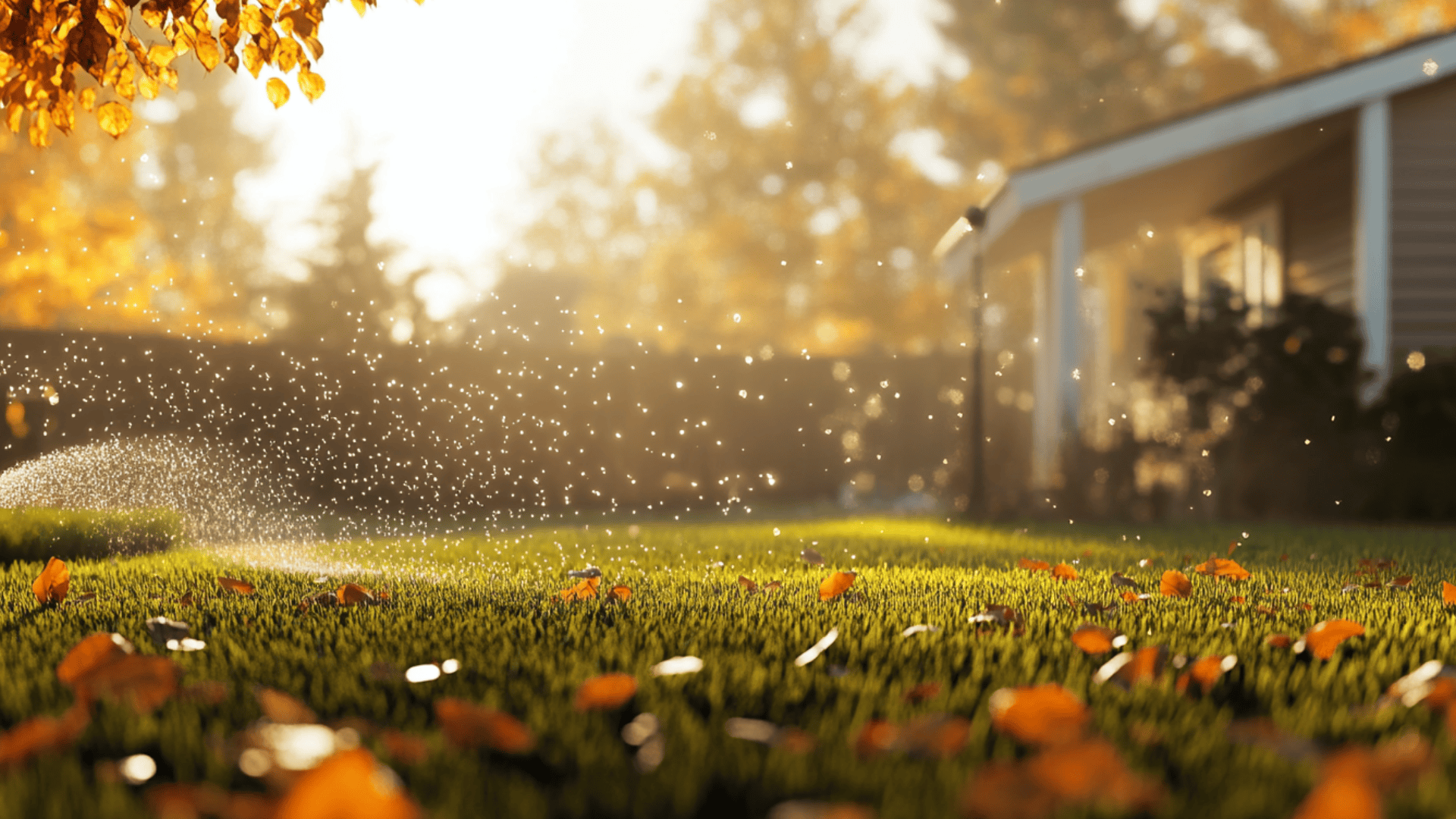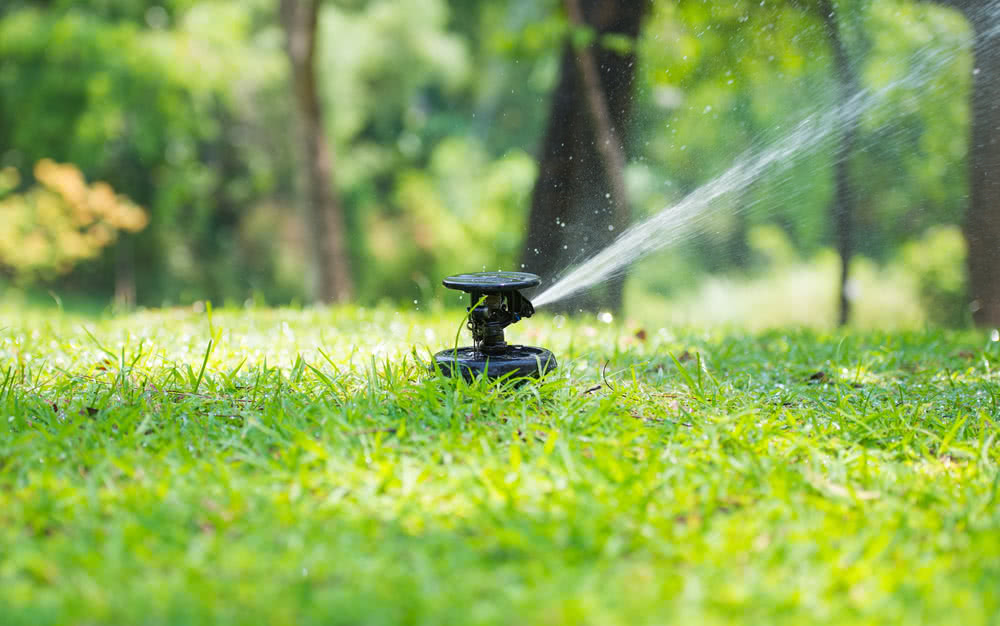How to Keep Roses Alive: Expert Secrets for Lasting Blooms
I’m excited to share my guide on keeping roses alive!
Caring for roses can be simple and enjoyable when you know the right steps.
In this blog, I’ll walk you through expert tips to help your roses thrive and bloom for longer.
I’ll cover everything from choosing the best spot for your roses to watering them correctly.
You’ll learn how to feed your plants, protect them from pests, and how to prune them for the best results.
Whether you’re new to gardening or have been growing roses for years, you’ll find useful info here.
Get ready to turn your garden into a beautiful, long-lasting rose display with these easy-to-follow tricks!
Understanding Rose Lifespan: Cut Roses vs. Potted Roses
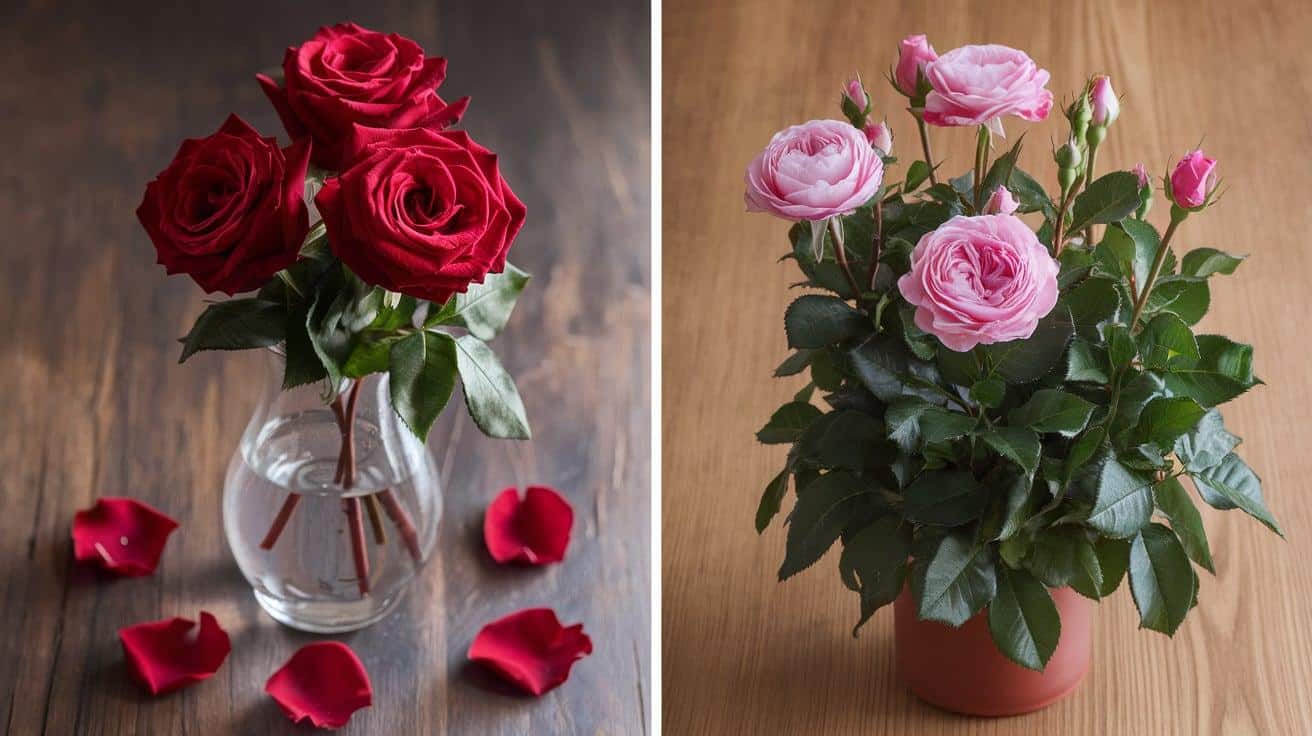
Roses are loved by many, but their care needs can vary depending on whether they’re cut or potted.
In this section, I’ll explain the key differences between caring for cut roses in a vase and potted roses, whether they’re kept indoors or outdoors.
I’ll also shed light on how their natural lifespans differ, helping you set realistic expectations for your blooms.
Differentiate between the care needs of cut roses in a vase and potted roses indoors or outdoors:
| Care Aspect | Cut Roses in a Vase | Potted Roses Indoors or Outdoors |
|---|---|---|
| Watering | Need fresh water daily | Need regular watering, but not daily |
| Nutrients | Benefit from flower food in the water | Require proper soil and occasional fertilizing |
| Pruning | Require stem trimming every few days | Need pruning for shape and health |
| Light Requirements | Thrive in cool spots away from direct sunlight | Prefer sunlight but may need some shade in hot climates |
| Lifespan | Shorter lifespan, typically 5-7 days | Can live for many years with proper care |
Explain how their lifespans differ naturally:
Cut roses:
- Once cut, they’re separated from their nutrient source
- Their lifespan is limited to about a week
- Proper care can extend their beauty for a few extra days
Potted roses:
- Connected to their root system, they can grow and bloom repeatedly
- With good care, they can live for several years
- They go through natural growing cycles, including dormant periods
By understanding these differences, you can provide the right care for your roses, whether they’re in a vase or a pot, and enjoy their beauty for as long as possible.
Helpful Tips for Cut Roses Alive Longer (In a Vase)
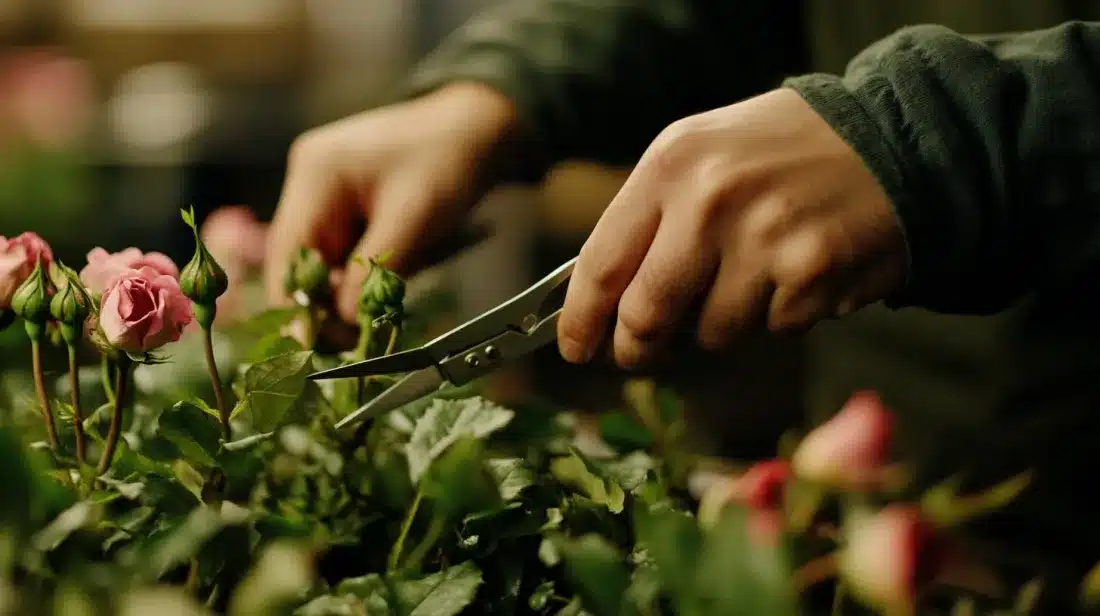
I’ll share ten key tips to help your cut roses stay fresh and beautiful for as long as possible. These simple yet effective methods focus on proper care techniques that anyone can use at home.
From initial preparation to ongoing care, these tips will help you get the most out of your lovely blooms.
1. Cut Stems Under Water
When you trim rose stems, do it underwater.
This stops air bubbles from blocking the stem’s water uptake.
Use sharp scissors and cut about an inch off the bottom.
This method allows roses to drink more water, keeping them fresh longer.
2. Use Lukewarm Water with Lemon Juice
Fill your vase with lukewarm water.
The warmth helps roses drink more easily.
Add a squeeze of lemon juice to lower the water’s pH.
This makes it harder for bacteria to grow.
The result? Cleaner water and healthier roses that last longer.
3. Add a Copper Coin to the Vase
Drop a clean penny into your vase.
The copper acts like a natural cleaner, slowing down bacterial growth in the water.
Less bacteria means your roses stay fresher for more days.
Make sure to use a penny minted before 1982 for best results.
4. Change Water Every 2 Days
Replace the water in your vase every other day.
This gets rid of any build-up of bacteria or debris.
When you change the water, give the stems a quick rinse too.
Fresh, clean water keeps your roses looking their best for longer.
5. Mist Roses with Water
Spray a fine mist of water on your rose petals daily.
This adds moisture, especially helpful in dry rooms.
Use room temperature water and mist in the morning.
This extra humidity keeps petals soft and colorful, extending the life of your roses.
6. Remove Leaves Below Waterline
Take off any leaves that will be under the water in your vase.
Wet leaves rot quickly and make the water dirty.
This can lead to stem blockage and shorter rose life.
Keeping the stems clean in the water helps your roses drink better and last longer.
7. Trim Stems at an Angle
Cut the bottom of the stems at a 45-degree angle.
This creates more surface area for water uptake.
It also stops the stem from sitting flat on the vase bottom, which can block water absorption.
Trim about half an inch every few days to keep the stems fresh.
8. Use a Clean Vase
Always start with a spotless vase.
Wash it with hot, soapy water and rinse well.
This removes any leftover bacteria or residue.
A clean vase means cleaner water, which leads to healthier roses that stay fresh for more days.
9. Avoid Placing Roses Near Fruit
Keep your roses away from fruit bowls.
Ripening fruits give off a gas that makes flowers age faster.
This is especially true for apples and bananas.
Putting your roses in a different room from fruit can add days to their vase life.
10. Keep Roses in a Cool Spot
Find a cool place for your roses, away from heat sources and direct sun.
Avoid spots near radiators, air vents, or sunny windows.
Cooler temperatures slow down the aging process.
This simple step can add several days to your roses’ lifespan.
Helpful Tips for Potted Roses Alive Longer (Indoors or Outdoors)
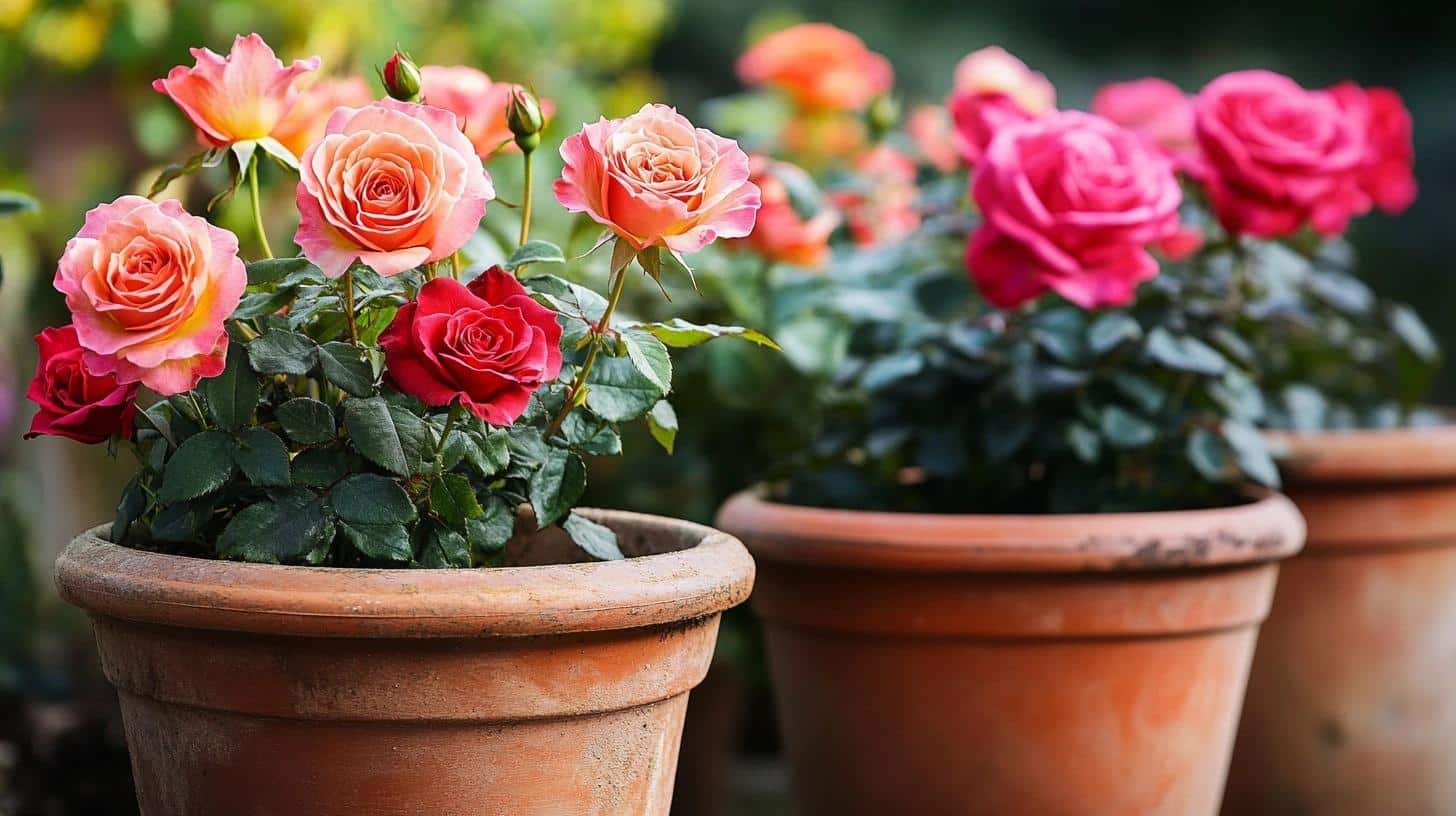
Growing roses in pots can be rewarding, whether indoors or outdoors. Here are ten key tips to help your potted roses thrive and bloom beautifully. These methods cover watering, soil care, pruning, and feeding, ensuring your roses stay healthy and long-lasting in containers.
1. Water at the Base, Not the Leaves
Direct water to the base of your rose plant.
This method keeps leaves dry, reducing the risk of fungal issues like black spot or mildew.
Wet foliage can create ideal conditions for these problems, so focus on hydrating the roots where it’s most needed.
2. Use Mulch to Conserve Moisture
Add a layer of mulch to your potted roses.
This helpful practice keeps soil moist, maintains cool root temperatures, and prevents weed growth.
By using mulch, you ensure your roses get more of the water and nutrients they need to flourish.
3. Deadhead Spent Blooms Regularly
Remove faded flowers from your rose bush often.
This simple task redirects the plant’s energy towards new growth and more blooms, rather than seed production.
Regular deadheading is an easy way to promote continuous flowering throughout the season.
4. Apply Epsom Salt for Lush Growth
Occasionally use Epsom salt on your roses.
Its magnesium content can improve leaf health and may lead to more abundant blooming.
Apply sparingly and not too frequently for the best results, following package instructions for proper dosage.
5. Prune During Dormant Season
Trim your roses when they’re not actively growing.
This helps shape the plant and removes dead or weak branches.
Pruning during dormancy prepares your roses for healthy growth in the coming spring, setting the stage for a beautiful display.
6. Use Well-Draining Soil
Ensure your pot has soil that drains well.
Proper drainage prevents water from sitting in the pot, which can lead to root rot.
Well-draining soil keeps your rose’s root system healthy and promotes overall plant vitality.
7. Rotate the Pot
Turn your rose pot regularly.
This simple action ensures all sides of the plant receive equal sunlight exposure.
Even light distribution leads to balanced growth, preventing your rose bush from becoming lopsided or stretching towards one light source.
8. Provide Adequate Sunlight
Give your roses plenty of sun – they need at least 6 hours daily.
However, in very hot climates, some afternoon shade can be beneficial.
Find the right balance of sun exposure for your specific location to keep your roses thriving.
9. Fertilize During the Growing Season
Feed your roses with balanced plant food during active growth periods.
This provides essential nutrients for healthy development and plentiful blooms.
Follow feeding instructions carefully to avoid over-fertilizing, which can harm your plants.
10. Repot Every 2-3 Years
Move your roses to a new pot with fresh soil every couple of years.
This gives roots new space to grow and ensures the soil has all the nutrients the plant needs.
Repotting reinvigorates your roses and supports their long-term health.
Essential Hydration and Nourishment for Long-Lasting Roses
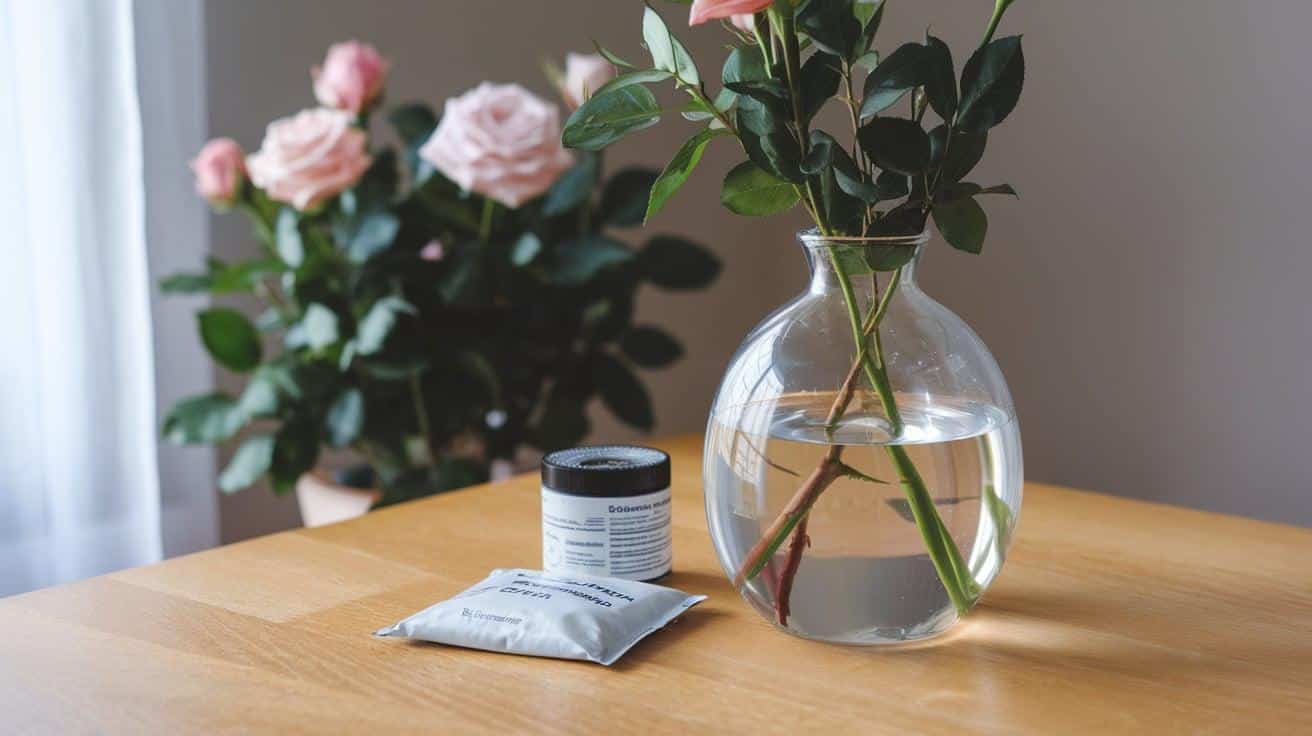
Proper hydration and nourishment are key to keeping roses healthy and beautiful, whether they’re cut or potted. This section covers the specific needs of both types, ensuring your roses stay fresh and vibrant for as long as possible. Let’s look at water care, feeding methods, and soil conditions that help roses thrive.
For Cut Roses
Water-changing frequency:
Change the water in your vase every 1-2 days.
Fresh water helps prevent bacteria growth and keeps stems clean.
When changing water, gently rinse the stems to remove any buildup.
Using lukewarm water:
Fill your vase with lukewarm water.
This temperature is easier for roses to absorb, helping them stay hydrated longer.
Avoid hot or cold water, as these can shock the stems and reduce the flowers’ lifespan.
Adding preservatives:
Mix in flower food or try home remedies to extend vase life.
A teaspoon of sugar can provide energy, while a crushed aspirin tablet may help prevent wilting.
Commercial flower preservatives often work best, combining food and antibacterial agents.
For Potted Roses
Balanced watering routine:
Water potted roses when the top inch of soil feels dry.
Avoid overwatering, which can lead to root problems.
In hot weather, you might need to water daily, while in cooler periods, once or twice a week may suffice.
Fertilization schedules:
Feed potted roses every 4-6 weeks during the growing season with a balanced, rose-specific fertilizer.
Reduce feeding in late summer to prepare the plant for dormancy.
Always water thoroughly after fertilizing to help distribute nutrients.
Importance of well-drained soil:
Use a potting mix designed for roses or create your own with good drainage.
This prevents water from pooling around roots, which can cause rot.
Add perlite or coarse sand to improve drainage if needed.
How to Protect Your Roses from Wilting, Disease, and Decay?

Keeping roses healthy requires vigilance and care. This section covers how to spot and prevent common issues in both cut and potted roses. Let’s look at ways to keep cut roses fresh longer and how to protect potted roses from diseases. By following these tips, you can enjoy beautiful, thriving roses for extended periods.
For Cut Roses
Identifying early signs of wilting and how to prevent it:
Watch for drooping petals or bent stems, which are early signs of wilting.
To prevent this, recut stems at a 45-degree angle under running water every few days.
Keep roses away from direct sunlight, heat sources, and ripening fruit, which release gases that can speed up wilting.
How to sanitize vases and tools to avoid bacterial contamination:
Clean vases thoroughly with hot, soapy water before use.
Rinse well to remove all soap residue.
For extra protection, use a mild bleach solution (1 part bleach to 10 parts water) to sanitize vases and cutting tools.
Always rinse tools after using the bleach solution.
For Potted Roses
Common diseases like black spot and powdery mildew, and how to treat or prevent them:
Black spot appears as dark marks on leaves, while powdery mildew looks like a white, powdery coating.
To prevent these, avoid wetting leaves when watering.
If diseases appear, remove affected parts and use a fungicide made for roses.
Good air flow and proper spacing between plants also help prevent these issues.
Tips for pruning and airflow maintenance:
Prune your roses regularly to remove dead or diseased parts and improve air flow.
Cut at a 45-degree angle just above an outward-facing bud.
Space your rose plants properly to allow good air movement between them.
This helps prevent moisture buildup that can lead to diseases.
Ideal Environmental Conditions for Thriving Roses
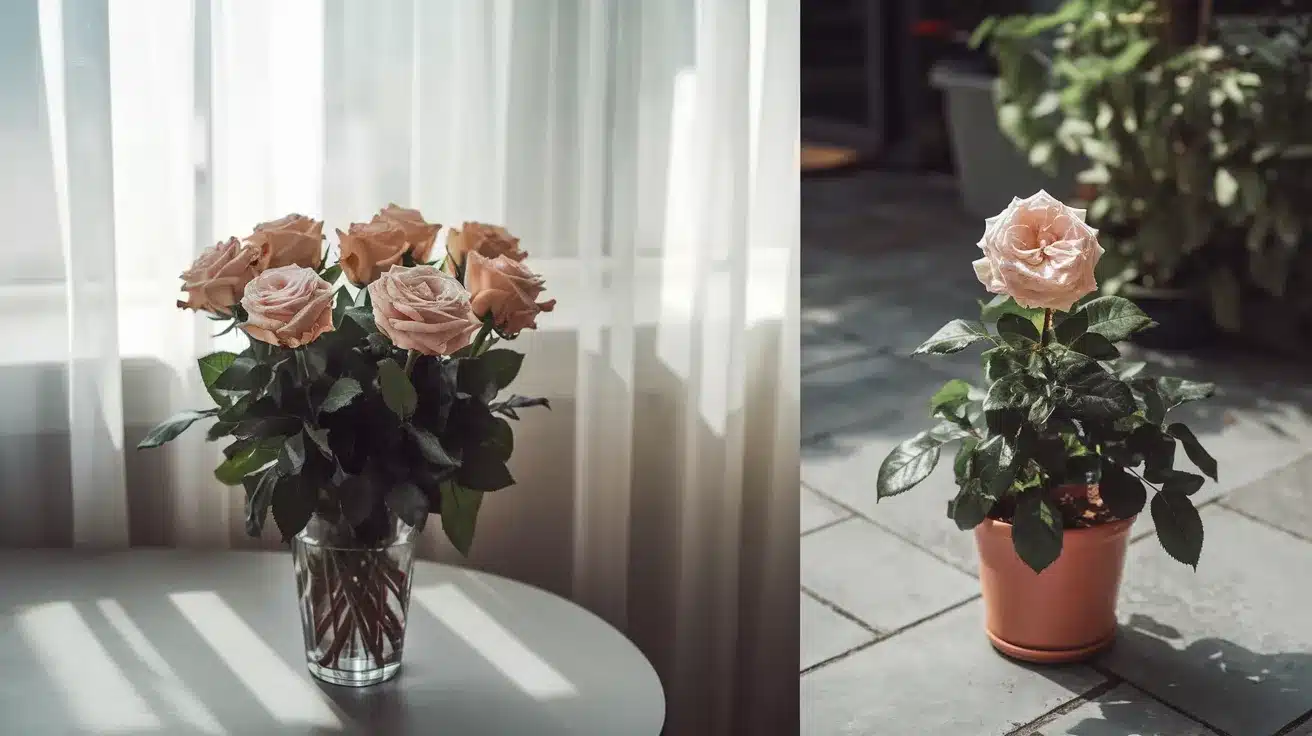
Creating the right environment is crucial for keeping roses healthy and vibrant. In this section explore the best conditions for both cut and potted roses. By understanding and providing these ideal settings, you can help your roses last longer and bloom more beautifully.
For Cut Roses
Ideal temperature, light, and humidity conditions for extending their vase life:
Temperature: Keep cut roses in a cool spot, ideally between 65-72°F (18-22°C). Avoid placing them near heat sources or in direct sunlight, as warmer temperatures can speed up aging. At night, moving them to a cooler area (around 60°F or 15°C) can help extend their life.
Light: Place cut roses in a bright area, but out of direct sunlight. Too much direct light can cause roses to wilt faster. Soft, indirect light is best for maintaining their color and freshness.
Humidity: Roses prefer moderate humidity, around 40-50%. In dry environments, you can mist the air around the roses lightly, but avoid getting water directly on the petals. Too much moisture can lead to mold growth.
For Potted Roses
Best indoor and outdoor environments, and tips for positioning them away from heat sources, drafts, or direct sunlight:
Indoor Environment: Choose a spot with good air flow and plenty of natural light. A south-facing window is often ideal, providing enough light without overheating the plant. Keep roses away from air vents, radiators, and drafty windows to prevent stress on the plant.
Outdoor Environment: Potted roses outdoors do best in areas that get morning sun and afternoon shade, especially in warmer climates. This balance provides enough light for growth while protecting them from the harshest midday sun.
Positioning Tips:
- Avoid placing roses near heat sources like fireplaces or heating vents.
- Keep them away from cold drafts from doors or windows.
- If indoors, rotate the pot weekly to ensure even growth and light exposure.
- In hot climates, provide some afternoon shade to prevent leaf burn.
- Group potted roses together outdoors to create a microclimate with higher humidity.
By paying attention to these environmental factors, you can create the best conditions for your roses, whether they’re in a vase or a pot. This care will help ensure your roses stay healthy, vibrant, and long-lasting.
Expert Methods for Prolonging Rose Freshness
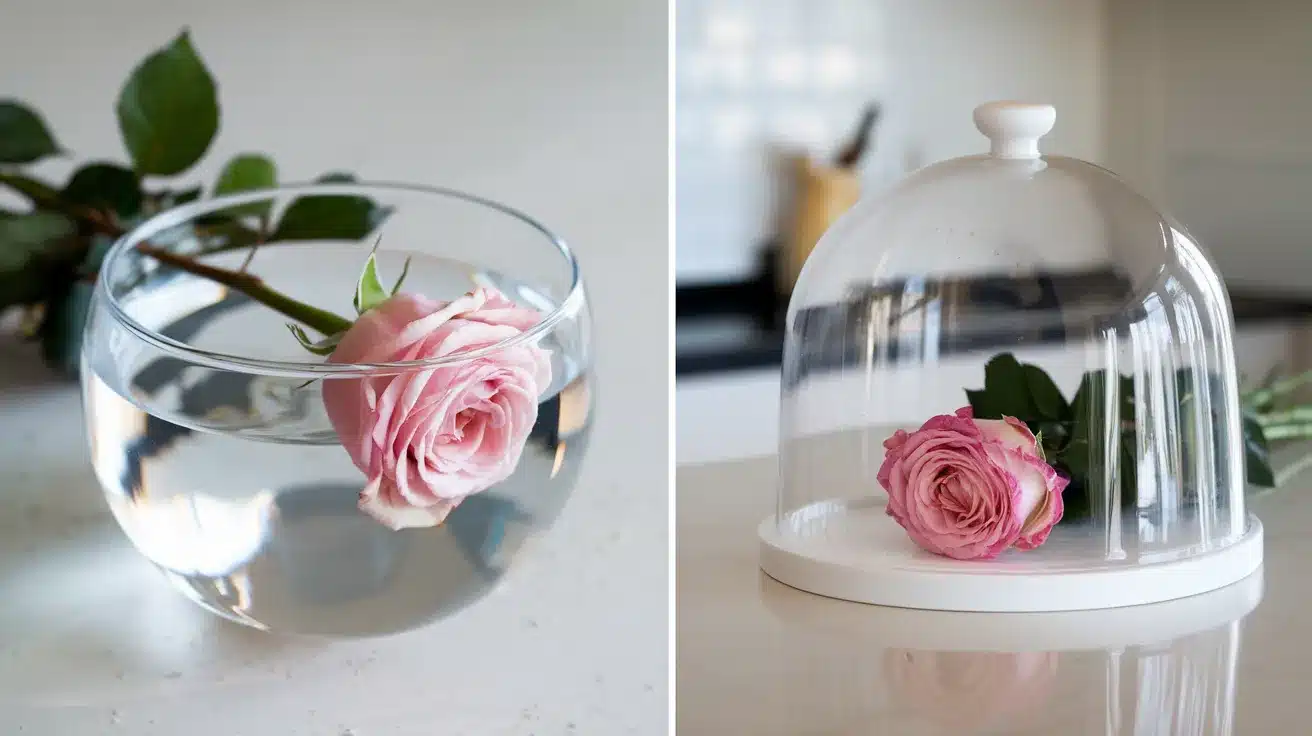
Keeping roses fresh for as long as possible is a skill many flower enthusiasts aim to master. In this section, I’ll share some expert techniques that can help extend the life of your roses. These methods go beyond basic care, offering specialized approaches to maintain the beauty and vitality of your blooms.
Hydration Tricks
Submerge roses in water baths to revive them:
When roses start to droop, a water bath can work wonders. Here’s how to do it:
- Fill a sink or bathtub with lukewarm water.
- Cut about an inch off the stems at a 45-degree angle.
- Submerge the entire rose, including the bloom, in the water.
- Leave them for 1-2 hours.
- Remove, shake off excess water, and place in a vase with fresh water.
This method can help rehydrate roses that have become limp or wilted, often breathing new life into them.
Humidity Chambers
Create a humid environment to extend freshness:
Roses love humidity. You can create a mini humidity chamber to keep them fresh:
- Take a large, clear plastic bag.
- Mist the inside of the bag lightly with water.
- Carefully place the vase with roses inside the bag.
- Blow air into the bag to inflate it slightly, then seal it.
- Place the bagged arrangement in a cool spot out of direct sunlight.
This method traps moisture around the roses, slowing water loss and keeping them fresh longer. Just be sure to check daily and remove any fallen petals to prevent mold.
Re-cutting Stems
When and why to re-cut stems to improve water uptake:
Regular re-cutting of stems is key to keeping roses fresh:
- Re-cut stems every 2-3 days, or when you change the water.
- Cut at a 45-degree angle, about 1 inch from the bottom.
- Use sharp, clean scissors or a knife to avoid crushing the stems.
- Cut stems under running water or submerged in water to prevent air bubbles.
This technique opens up the stem’s water channels, allowing for better hydration. It’s especially important if you notice your roses starting to wilt or if the stem ends look discolored.
By using these expert methods, you can significantly extend the freshness of your roses, allowing you to enjoy their beauty for much longer.
Household Hacks to Keep Your Roses Vibrant
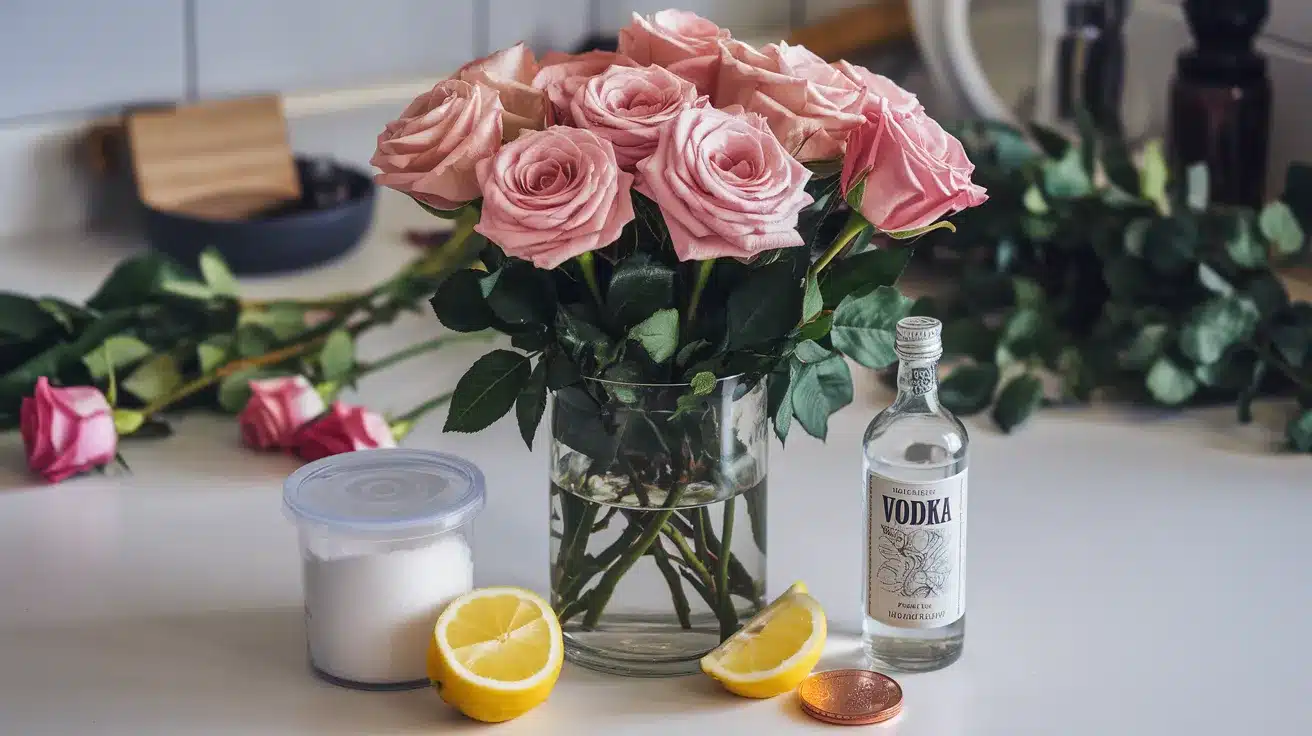
Keeping cut roses fresh doesn’t always require special products. Many items you already have at home can help extend the life of your flowers. Here are five simple kitchen tricks to keep your roses looking beautiful for longer.
1. Add Sugar to the Water
Mix a teaspoon of sugar into your vase water. This gives roses extra food, helping them stay colorful and healthy for more days.
2. Use Vinegar to Prevent Bacterial Growth
Put a teaspoon of vinegar in the vase water. This makes the water a bit sour, which stops bacteria from growing and keeps your roses fresher.
3. Use a Small Amount of Vodka
Add a few drops of vodka to the vase. It works like a cleaner, stopping bacteria from growing in the water.
4. Aspirin in the Water
Crush an aspirin and add it to the water. This helps roses take in water more easily, keeping them fresh longer.
5. Bleach to Keep Water Clear
Use one tiny drop of bleach in the vase water. It kills bacteria and keeps the stems clear so roses can drink easily.
Conclusion
As i wrap up this guide on keeping roses alive, remember that with the right care, your roses can thrive and bloom beautifully for longer.
Whether you’re tending to cut roses in a vase or potted roses in your garden, the key is providing proper hydration, nourishment, and protection.
From using household items like sugar and vinegar to maintain freshness, to creating ideal environments and preventing diseases, these tips will help you enjoy vibrant roses.
Remember to water wisely, feed regularly, and keep an eye out for early signs of problems.
With the expert secrets, you’re now equipped to nurture your roses and create stunning displays that last.
Why not put these tips into practice today? Your roses will thank you with their enduring beauty and fragrance.
Frequently Asked Questions
How long do cut roses typically last?
Cut roses usually last 5-7 days in a vase. With proper care, they can stay fresh for up to two weeks.
Can I revive wilted roses?
Yes, you can often revive wilted roses. Recut the stems at an angle, place them in warm water, and keep them in a cool spot. They may perk up in a few hours.
Is it necessary to remove thorns?
It’s not necessary to remove rose thorns. However, removing them can make handling easier and prevent damage to other flowers in arrangements.
Can I use tap water for my roses?
Tap water is fine for roses. If your tap water is very hard, consider using filtered water. Let the water sit for a few hours to let chlorine evaporate for best results.

